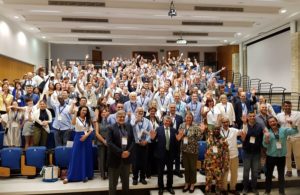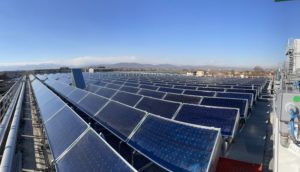Switzerland: The Advantages of Solar Thermal and Heat Pump Combinations
December 17, 2013
Combining a heat pump and a solar thermal system increases overall system efficiency and substantially reduces the heat pump’s electricity consumption. The various possibilities of using both technologies together were illustrated by Dr Michel Haller’s presentation entitled “Solar and Heat Pump Systems – A Question of Technology?” and held at the SHC conference in Freiburg (see attached document). Haller is project leader at the Swiss Institute for Solar Technology, SPF, in Rapperswil. The ideal combination depends on the type of application, the type of collector and the local climate conditions. The figure above shows a common parallel configuration.
“The key figure is the ratio of delivered heat to electricity consumed over the entire year,” Haller explained in his speech. This ratio is expressed by the Seasonal Performance Factor, which is between 2.5 and 5 for an air source heat pump and between 40 and 120 for a solar thermal system. But because investment costs increase in proportion to the solar fraction, and because these costs are fairly high for a fraction of 100 %, the effort to combine both technologies seems worthwhile. In this case, the solar system will cover 100 % of the heat demand in summer and a certain share in spring and autumn, whereas the heat pump will supply most of the heat during the winter months.
The research in this field is being carried out by the SPF in the frame of the IEA SHC Task 44 and the EU FP7 project MacSheep. The focus is on developing and evaluating new system designs with the help of computer-aided simulations and measurements of new designs in the test stand using the so-called Concise Cycle Test (CCT). The CCT is a dynamic test method for the entire system and was developed at the SPF to test hybrid systems. The complete system, including the energy storage, the backup heater, the hydraulic, and the control unit, is set up at the indoor test facility of the SPF. Domestic hot water and space heating loads, as well as the collectors in the solar circuit are then emulated through controllable heat sources and sinks in real time.
Basically, the researchers divide system configurations into solar and heat pump systems operated parallel or in series. If run parallel, the solar system and heat pump are both used as an independent heat source for heating and domestic hot water. A serial configuration means that the solar system provides energy to the evaporator of the heat pump, or – alternatively – can regenerate the ground of a ground-source heat pump.
“There is evidence that designs which combine parallel and serial configurations can achieve a better Seasonal Performance Factor than systems connected only in parallel, given certain boundary conditions or applications,” Haller said. “But there is no evidence that serial configurations fare much better than parallel ones.” According to Haller, the advantage of designs with systems connected in series over designs with systems connected in parallel is greater for applications which demand higher temperatures. These could be industrial applications, DHW or space heat distribution with 50°C. In addition, serial configurations make sense when there is low solar irradiation – which is not used effectively by collectors running parallel – and may prove interesting when it comes to uncovered solar absorbers.
In addition to parallel and serial system configurations, Haller also compared PV yields and electric savings from adding solar thermal to a heat pump system. “Electric savings from solar thermal collectors per m2 of roof area are in the same range as the PV yield at a given location, assuming that you can use 100% of the PV yield,” Haller stated. Electric savings should be higher for small solar fractions of large-scale solar thermal DHW systems, for example, in multi-family houses. They are often lower for solar combi systems. “PV and heat pump is and will be serious competition for solar thermal and heat pump combinations,” Haller concludes. But, “it is not easy making a fair comparison: For example, solar thermal is usually stored onsite, whereas PV electricity is fed into the grid. However, it is not relevant to the carbon footprint of local energy demand what has been traded to the grid, but what is bought from the grid. Today’s feed-in tariffs and subsidies for PV are distorting the market in favour of PV. In the end, the decision to install PV and heat pump or solar thermal and heat pump may be more a question of subsidies or policies than a question of what is the better technology.” Emerging technologies, such as combined PV/T collectors, may provide a way out of this dilemma – or create more competition on the market.
More information:
http://www.solarenergy.ch
http://task44.iea-shc.org/
http://macsheep.spf.ch/


